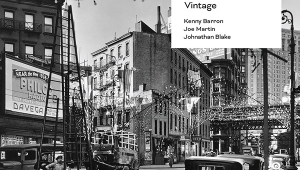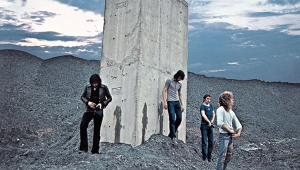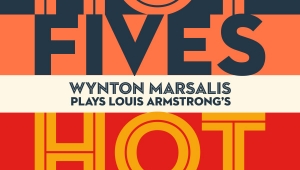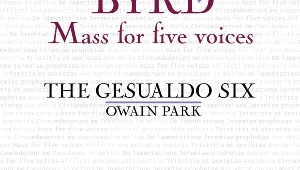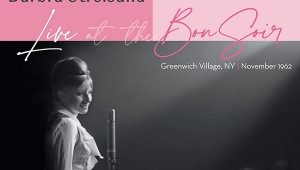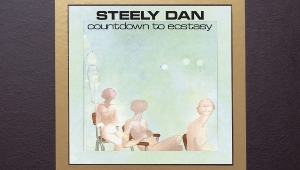| Columns Retired Columns & Blogs |
Recording of March 2010: Neil Young Official Release Series, Discs 1–4
Neil Young: Official Release Series, Discs 1–4
Reprise 519173-1(4 LPs, Limited Edition Vinyl Boxed Set). 2009. Neil Young, David Briggs, Elliot Mazer, Jack Nitzsche, Henry Lewy, prods.; John Nowland, reissue eng. AAA.
Reprise 519173-1(4 LPs, Limited Edition Vinyl Boxed Set). 2009. Neil Young, David Briggs, Elliot Mazer, Jack Nitzsche, Henry Lewy, prods.; John Nowland, reissue eng. AAA.
One of the biggest music stories of 2009 is the "return" of vinyl. For grizzled vets, particularly of the audiophile ilk, vinyl never went away in the first place, but that's a rail for another time.
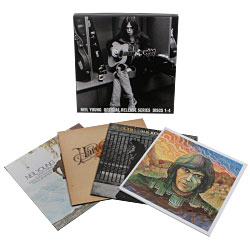 A flagrant irony about this latest vinyl revival is that much of it has been led by the same record labels who, not so long ago, worked so assiduously to kill the LP, so that their customers would have to replace their vinyl libraries, at vastly higher prices, with CDs—which now, in yet another dizzying twist, have themselves become the object of the record business's murderous disaffection.
A flagrant irony about this latest vinyl revival is that much of it has been led by the same record labels who, not so long ago, worked so assiduously to kill the LP, so that their customers would have to replace their vinyl libraries, at vastly higher prices, with CDs—which now, in yet another dizzying twist, have themselves become the object of the record business's murderous disaffection.
While LPs of new releases, mostly of indie rock, are the cool tip of vinyl's resurgence, much of the "new vinyl" now gushing on to the market has been reissues of catalog pieces from labels large and small. Most are previous best-selling albums pressed on high-quality vinyl in limited editions, with great attention paid to packaging and, in some cases, fresh mixes. In other words, this is vinyl as it should have been done—but rarely was—during its 30-year heyday as the best-sounding and most popular music medium. The problem with the new reissues is that while those new to LPs may get a rush out of buying the Beach Boys' Pet Sounds or Paul McCartney's Band on the Run in vinyl, to everyone else, the majority of new LPs rate a mildly interested shrug. For vinyl's new lease on life to take hold, and for it to become a permanent part of the musical landscape, new releases need to be consistently available, and the reissue base has to spread into obscurities and less commercial titles. In both cases, there has to be a firm commitment to quality pressings and packaging. And that is what the Neil Young Official Release Series, Discs 1–4 is all about.
Young's endless tinkering with his recorded catalog, in both audio and video forms, is legendary. At least a decade ago, he began talking about curating collections of his live and studio recordings. Over the years, rumors continually leaked from Young's notoriously secretive camp, but in the end nothing happened. In 2006, the dam broke when he released Live at the Fillmore East, followed by Live at Massey Hall and Chrome Dreams II (2007) , and Sugar Mountain: Live at Canterbury House 1968. In 2009 he stepped up the pace, releasing Fork in the Road, an environmental manifesto of sorts; a new live set, Dreamin' Man Live '92 , which revisits the material on 1992's Harvest Moon; and the long-awaited coup de grÉce (for now), Archives Vol.1: 1963–1972, a 10-disc Blu-ray/DVD/CD set that tells the story of Young's first decade in music. Finally, there's the sweetest item in this overwhelming mass o' Neil: the release of his first four solo records on 180gm vinyl, collected in a boxed set with the elegant title Neil Young Official Release Series, Discs 1–4.
Few individuals in the history of rock music have had as long or as prolific a solo career as has Neil Young. Even including Bob Dylan—whose determination, particularly in touring, has pushed him into the realm of the supernatural—Young has no peer in remaining musically committed and relevant. He continues making good-to-great records, and his live shows have, if anything, gained a step. But it's in this quartet of albums, from Neil Young and Everybody Knows This Is Nowhere (both released in 1969) through After the Gold Rush (1970) to his breakthrough, Harvest (1972), that the legend of ol' Neil (to quote Lynyrd Skynyrd) is firmly grounded. While Young's first two albums are both fine collections of songs that have been underrated since the appearance of the two that followed, it's the After the Gold Rush and Harvest that, to this day, remain absolutely stunning displays of original songwriting.
Of the two albums' 21 songs, Young wrote the words and music for all but one. On Gold Rush, his blend of bittersweet balladry reached previously unimagined heights with "Only Love Can Break Your Heart"; his tuneful, twangy, mid-tempo folk-rock was sharp and focused on "Till the Morning Comes," "Tell Me Why," and "When You Dance You Can Really Love"; and in "Southern Man" he turns up the electric guitars and hits a protest vein that he skewers with even better aim in Harvest's "Alabama"—the tune that inspired Skynyrd's famed response, "Sweet Home Alabama." The energy and mastery so evident on Gold Rush is all the more amazing when you consider that Young was, at the time, part of CSN&Y, and had contributed two songs to Déjà Vu, released just four months before.
Young followed that success—one many Youngophiles consider his best—with a set that has to be near the top of any list of ageless classics. Artistically, Harvest sounds as fresh as the day it was made. "Heart of Gold," "The Needle and the Damage Done," and especially "Old Man," are outstanding. Thanks to John Nowland's tape restoration and new masters (the SACDs of these albums feature brilliant new 24-bit/176kHz digital transfers), the musicality of all these LPs is nothing short of glorious. While the records were generally well made to begin with (thanks to producers Eliot Mazer, David Briggs, and Jack Nitzsche), the depth of the soundstages and the sparkling, wide dynamic range of these pressings is very inviting—as is the packaging, which on Harvest features the kind of heavy, uncoated cover stock, tinted to simulate aging, that's been known to cause paroxysms of glee in vinylphiles. If, as Tom Petty says, the waiting is the hardest part, then the sound—as well as this timeless, assured music—has made the years of anticipation worth every minute.—Robert Baird
- Log in or register to post comments



